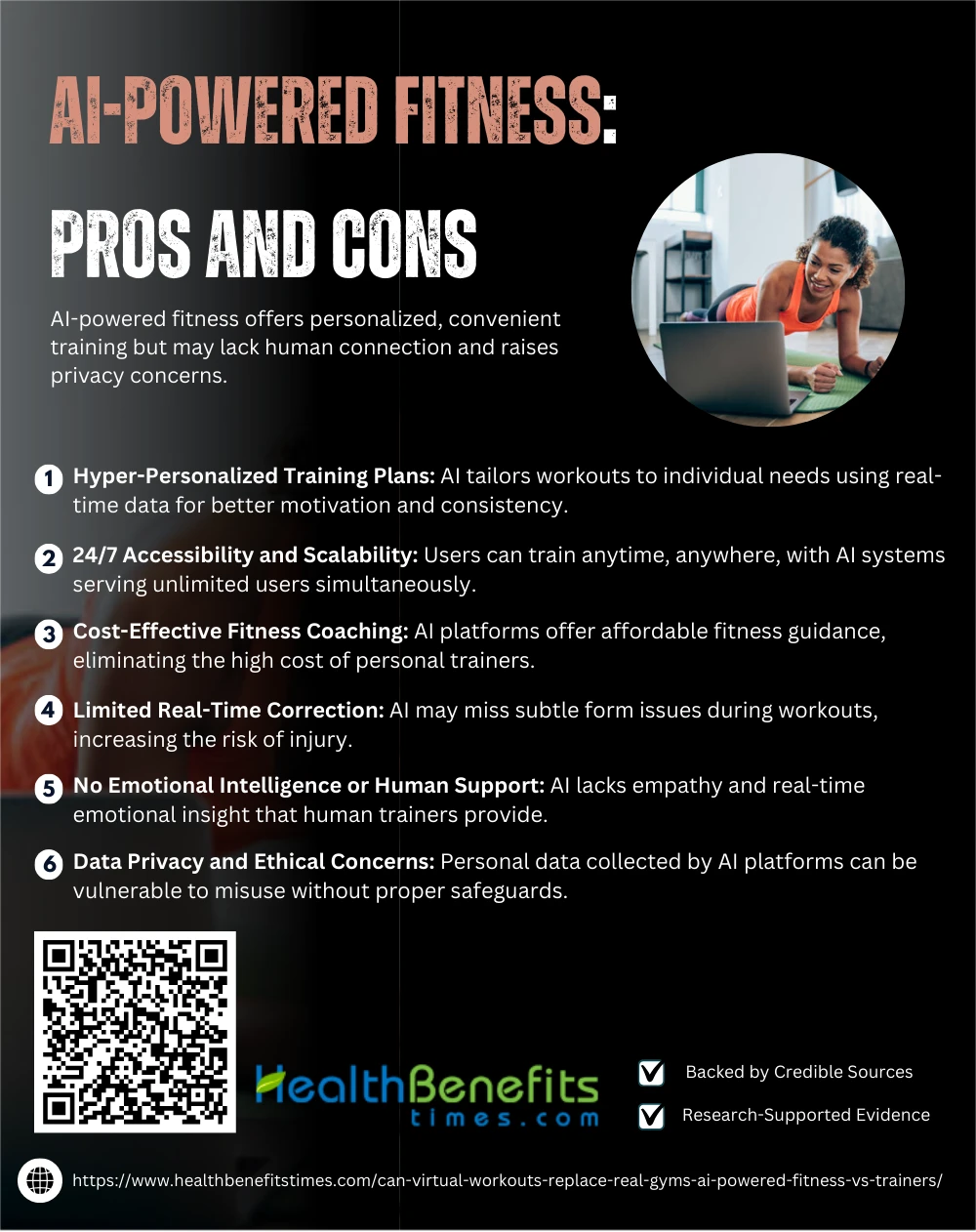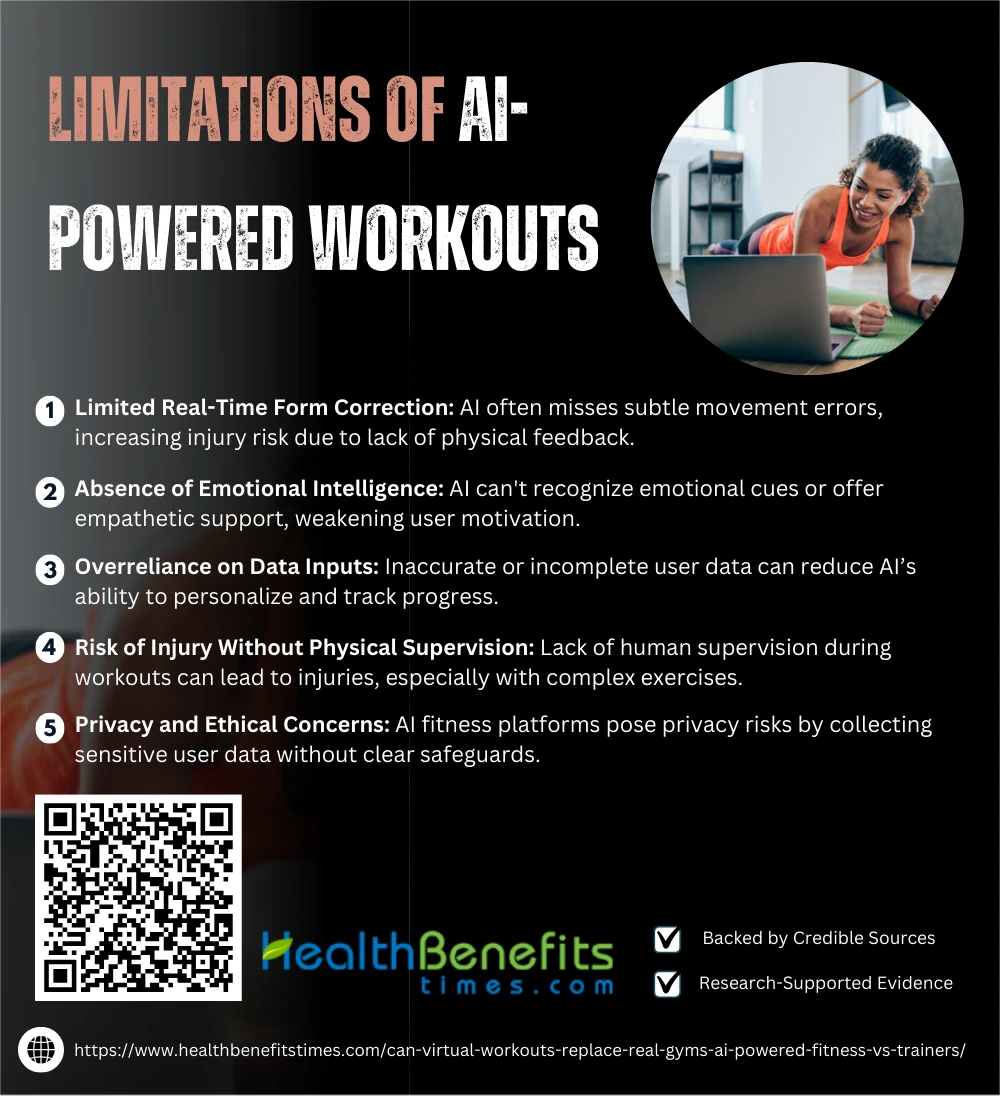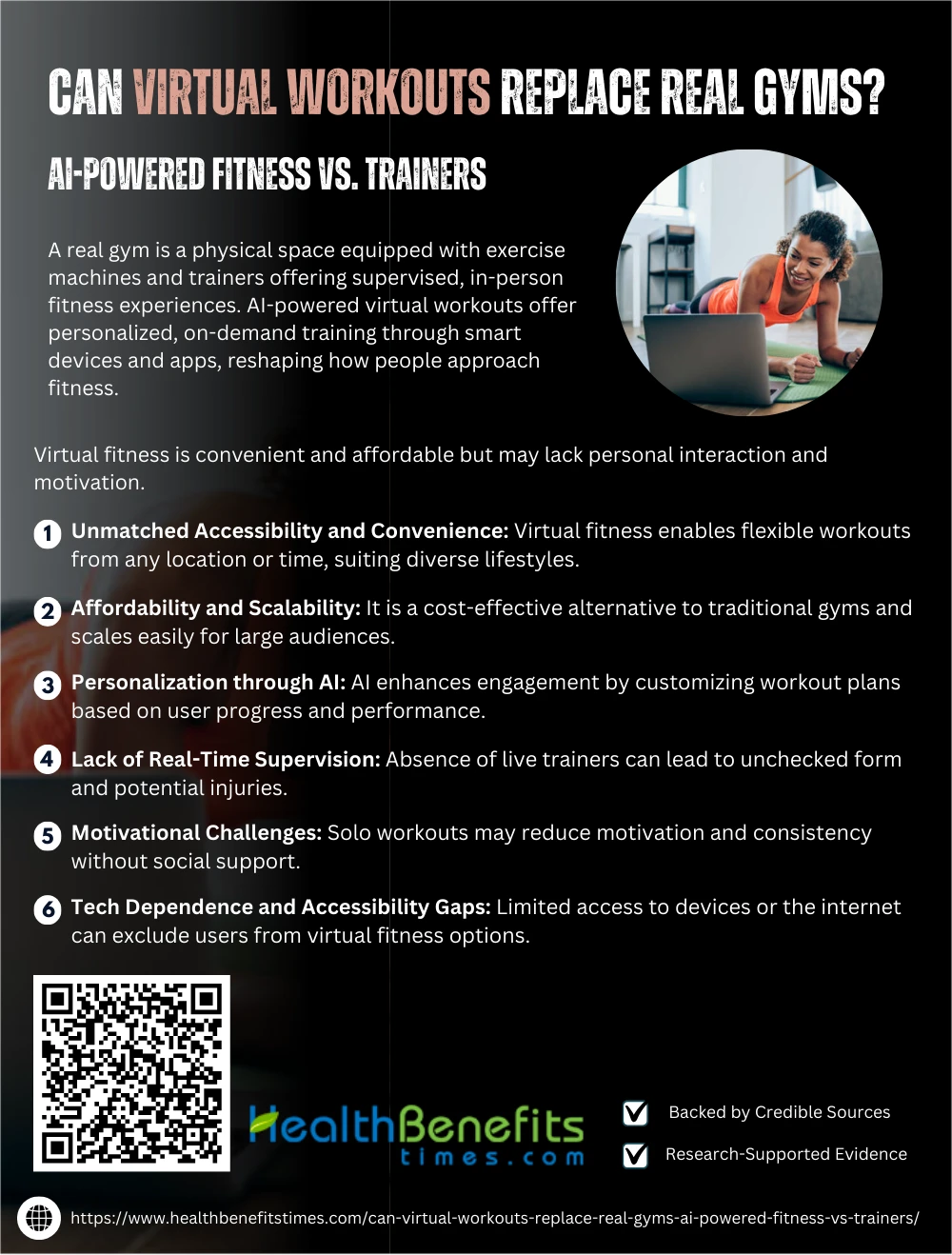- A real gym is a physical space equipped with exercise machines and trainers offering supervised, in-person fitness experiences.
- AI-powered virtual workouts offer personalized, on-demand training through smart devices and apps, reshaping how people approach fitness.
- Despite technological advances, human trainers still provide irreplaceable emotional support, real-time correction, and social accountability.
 A real gym refers to a physical space equipped with exercise machines, free weights, and designated areas for group training, typically supervised by certified fitness professionals. These settings provide structured programs and in-person coaching aimed at improving physical health, strength, and overall fitness. For more insight, refer to this comparative study on traditional fitness centers highlighting their benefits for personalized and holistic training. (1)
A real gym refers to a physical space equipped with exercise machines, free weights, and designated areas for group training, typically supervised by certified fitness professionals. These settings provide structured programs and in-person coaching aimed at improving physical health, strength, and overall fitness. For more insight, refer to this comparative study on traditional fitness centers highlighting their benefits for personalized and holistic training. (1)
As virtual platforms and AI-driven fitness solutions grow in sophistication and popularity, the question arises: can they truly replace the traditional gym experience? AI-powered fitness offers unmatched accessibility, customized routines based on biometric data, and lower long-term costs. However, despite these innovations, traditional gyms still offer key advantages like real-time human feedback and emotional engagement in group settings. According to a study from Temple University, in-person fitness training provides stronger accountability and motivation through social interactions and direct supervision. (2) Additionally, the ACSM’s Worldwide Fitness Trends report confirms that personal trainers and traditional gym-based programs remain consistently ranked among the top fitness methods, emphasizing the continued relevance of human-led fitness in a tech-heavy era. (3)
The Rise of Virtual Workouts
The global digital fitness landscape has experienced exponential growth in recent years, driven by advances in app development, smart devices, and data analytics. Mobile fitness platforms have gained massive traction due to their ability to deliver personalized and engaging workout routines. According to a 2022 study on fitness app usage, the mobile fitness market has shown rapid expansion due to features like biometric tracking and user-centered design, which enhance engagement and ease-of-use. (4)
The COVID-19 pandemic served as a powerful catalyst for this trend, as lockdowns and gym closures drove millions to explore online workout alternatives. Research during this period indicated a sharp increase in digital workout engagement, which persisted into the post-pandemic era, signifying a shift in consumer behavior. (5)
Moreover, the convenience and accessibility of virtual workouts remain unmatched. Users can train anytime and anywhere, bypassing common barriers like travel time or cost. (6)
What Is AI-Powered Fitness?
AI-powered fitness refers to the integration of artificial intelligence technologies—such as machine learning, computer vision, and real-time analytics—into fitness platforms that can tailor workouts, monitor performance, and guide users through virtual training sessions. Tools like smart mirrors, wearable trackers, and fitness apps now employ AI to enhance personalization and precision in exercise programming. As detailed in a recent study, these innovations are transforming fitness by merging physical activity with intelligent automation.
AI personalizes workouts by analyzing user-specific data such as age, heart rate, movement patterns, fitness level, and goals. These systems adapt training programs in real time, offering exercise modifications or intensity adjustments based on biometric input and behavior feedback. This dynamic personalization ensures consistency, progression, and safety throughout the fitness journey.
The key benefits of AI-powered fitness include accessibility, lower cost, 24/7 availability, and performance optimization—empowering users to stay active with precision and support wherever they are.
The Traditional Gym and Personal Trainers
Traditional gyms offer structured environments where certified trainers provide real-time feedback, helping users stay motivated and focused on form and consistency. These spaces also foster accountability and social engagement, enhancing adherence through community support and shared fitness goals. (1) Personalized attention from trainers aids in injury prevention and tailors workout progression based on individual needs, as detailed in Sweet’s behavioral study on exercise motivation and trainer influence.
Comparative Analysis: AI vs. Human Trainers
As the fitness landscape evolves, both AI-powered platforms and human trainers offer compelling advantages—but they differ in critical ways. Below is a comparison across core dimensions, backed by current research.
| Aspect | AI-Powered Fitness | Human Trainers |
| Personalization | Delivers data-driven plans based on metrics like heart rate, sleep, and performance history (7) | Builds routines based on observation, dialogue, and evolving client feedback (8) |
| Real-Time Feedback | Uses motion tracking or form correction algorithms, limited by camera angles and sensors (9) | Offers instant, hands-on feedback to correct form, prevent injury, and adapt on the fly (1) |
| Motivation & Support | Uses gamification, progress tracking, and reminders—but lacks emotional intelligence | Provides empathy, encouragement, and energy tailored to user mindset (10) |
| Accessibility | 24/7 availability, global reach, remote use with minimal cost | Requires scheduling, location-based sessions, and higher financial investment |
| Accountability | User-dependent; often limited to app notifications | Stronger due to human presence and relationship-based commitment |
| Injury Prevention | May flag form errors or strain but lacks tactile feedback | High effectiveness through direct observation and manual correction |
| Cost | Typically subscription-based or one-time device purchase; scalable | Higher long-term cost, but more adaptable to complex or changing needs |
| Social Interaction | Limited to leaderboards or forums | Rich in community building, shared progress, and peer motivation |
Virtual Fitness: Pros and Cons
Virtual fitness offers convenience, flexibility, and affordability, making it appealing to many. However, it also comes with limitations like reduced personal interaction and motivation. Let’s explore the pros and cons.
- Unmatched Accessibility and Convenience
Virtual fitness allows users to work out anytime and anywhere—ideal for busy schedules, remote locations, or those with mobility challenges. According to López-Gil (2025), virtual fitness improves participation by eliminating geographical and time-related barriers. - Affordability and Scalability
Many apps and programs cost significantly less than gym memberships or personal trainers. A study by Matthes et al. noted that cost-effectiveness is one of the key reasons for virtual fitness adoption. - Personalization through AI
AI-driven platforms adjust workout plans based on performance and progress, offering adaptive experiences. This form of customization has been shown to enhance user engagement. (11)
Cons of Virtual Fitness
- Lack of Real-Time Supervision
Without a trainer present, form correction and injury prevention are limited. Poor posture and movement can go unchecked, risking long-term harm. - Motivational Challenges
Staying motivated without social interaction or trainer accountability can be tough. Users often struggle with consistency and discipline in solo environments. - Tech Dependence and Accessibility Gaps
Those without stable internet, modern devices, or digital literacy may struggle to access quality virtual workouts. This digital divide was highlighted by Jerjes & Harding (2024). (12)
AI-Powered Fitness: Pros and Cons
AI-powered fitness uses smart algorithms to tailor workouts, track progress, and offer virtual coaching. While it brings innovation and convenience, it also raises questions about effectiveness and personal connection.
 Pros of AI-Powered Fitness
Pros of AI-Powered Fitness
1. Hyper-Personalized Training Plans
AI-powered fitness platforms excel at delivering highly customized workout routines based on an individual’s biometrics, history, and performance. Using inputs such as age, body weight, goals, injuries, and real-time performance data, AI can intelligently adapt training plans as users progress. For instance, platforms like Freeletics and Fitbod use predictive modeling to ensure exercises remain challenging yet achievable. This level of personalization has been linked to greater consistency and motivation, according to Donkor’s 2025 review on AI and exercise personalization. (7)
2. 24/7 Accessibility and Scalability
One of the major benefits of AI in fitness is its round-the-clock availability. Users can train at any time, from any location—perfect for those with tight schedules or who travel frequently. Moreover, once developed, AI systems can support an unlimited number of users simultaneously, something human trainers simply can’t do. This level of accessibility has democratized fitness for many, removing geographic and scheduling barriers that once limited consistent training.
3. Cost-Effective Fitness Coaching
Compared to personal training fees, AI-powered apps and platforms are significantly more affordable. Many charge a flat subscription rate or even offer free access to basic features. Over time, this creates a highly scalable and cost-efficient fitness solution that adapts without the recurring cost of human coaching. Especially for budget-conscious individuals, AI presents a way to maintain a structured fitness journey without compromising personalization or progress tracking.
Cons of AI-Powered Fitness
1. Limited Real-Time Correction
While AI platforms can offer feedback using sensors and video analysis, they often lack the real-time depth and nuance of a human coach. If a user performs an exercise incorrectly—especially a complex movement like a deadlift—AI might not catch the subtle mistakes that could lead to injury. Unlike a trainer who can intervene immediately, AI systems may miss crucial contextual cues, especially in live environments without integrated hardware.
2. No Emotional Intelligence or Human Support
AI can suggest routines and provide reminders, but it cannot replicate the human connection, encouragement, and empathy of a real trainer. Trainers motivate based on emotional cues and can push or pull back depending on a client’s state of mind. AI, on the other hand, offers algorithmic nudges that often lack relevance when users are dealing with personal struggles, low motivation, or emotional fatigue—times when human interaction can make a significant difference.
3. Data Privacy and Ethical Concerns
AI fitness platforms collect vast amounts of user data—heart rate, sleep, exercise habits, weight, and more. Without robust security protocols, this personal data could be vulnerable to breaches or misuse. Additionally, ethical questions arise regarding how this information is used, stored, or shared with third parties. The growing dependency on digital health tools means that users must be increasingly aware of their privacy rights and platform transparency.
Can AI Replace Human Trainers?
While AI-powered fitness tools offer personalized programming and 24/7 access, they lack the human trainer’s empathy and contextual judgment. AI excels in biometric data analysis and injury prediction, as shown in Guelmami et al. (2023), and provides scalable coaching. (13) (14) However, real-time form correction remains limited, and emotional support is absent. (15) (16) Additionally, ethical concerns about health data use persist. (17)
Limitations of AI-Powered Workouts
AI-powered workouts offer smart guidance, but they lack human intuition. Issues like improper form correction, limited emotional support, and difficulty adapting to real-time needs reveal key limitations in virtual coaching.
 1. Limited Real-Time Form Correction
1. Limited Real-Time Form Correction
AI-driven fitness platforms often rely on visual or sensor-based feedback, which can miss nuanced movement errors that a human trainer would catch instantly. This increases injury risk during complex exercises. Ganesh & Ramudhin (2024) emphasize AI’s constraints in posture recognition. (18) Similarly, Saklani (2023) and Jeganathan (2025) confirm AI’s limited biomechanical awareness. (19) (20) Mishra et al. (2025) and Rasa (2024) also note AI cannot deliver tactile correction or adapt form mid-motion effectively. (21) (22)
2. Absence of Emotional Intelligence
AI lacks the emotional intelligence critical for real-time motivation, empathy, and psychological support. It cannot interpret non-verbal cues like fatigue or frustration, nor provide nuanced encouragement. Davila-Gonzalez & Martin (2024) explain AI’s failure in emotional analytics. (23) Zaw Ye (2024) and Chew (2022) stress this emotional void in virtual coaching. (24) (16) Herman & Abeza (2025) and Narasannagari (2025) further argue emotional detachment hinders motivation and mental well-being. (25) (26)
3. Overreliance on Data Inputs
AI-powered fitness platforms depend heavily on user-generated data, which can be inconsistent, incomplete, or inaccurate. Without reliable biometric inputs, personalization and progression suffer. Jeganathan (2025) notes AI accuracy declines with limited data diversity. (20) Komalasari (2024) emphasizes data variability issues. (27) Waoo & Tiwari (2024), Zaw Ye (2024), and Kapoor (2021) highlight flawed personalization from incomplete or imprecise inputs. (28) (24) (29)
4. Risk of Injury Without Physical Supervision
Without in-person trainers to observe and intervene, AI cannot guarantee safety during workouts. This is especially risky for beginners and users performing complex movements. Saklani (2023) and Ganesh (2024) confirm that AI lacks real-time physical correction. (19) (18) Naveen et al. (2025) and Rasa (2024) show injury risks persist. (30) (22) Mishra (2025) further emphasizes AI’s limitation in adapting to unexpected physical scenarios. (21)
5. Privacy and Ethical Concerns
AI-powered fitness platforms collect vast amounts of sensitive biometric and behavioral data, raising significant privacy and ethical issues. Without transparent data governance, users face risks of misuse or third-party access. Komalasari (2024) highlights AI wearables’ data vulnerabilities. (27) Zaw Ye (2024) and Kapoor (2021) note low user awareness of privacy risks. (24) (28) Narasannagari (2025) and Shruthi et al. (2025) emphasize ethical gaps in data handling and consent mechanisms. (30) (25)
Conclusion
While virtual workouts and AI-powered fitness have revolutionized the way we stay active, they can’t fully replace the depth and personal touch of real gyms and human trainers. Technology offers unmatched convenience, customization, and innovation, but it still lacks the emotional intelligence, real-time correction, and motivation that come from face-to-face coaching. The future likely lies in a hybrid approach—blending the best of both worlds. Whether you’re a tech-savvy home exerciser or someone who thrives in a gym community, the key is finding what keeps you consistent, safe, and motivated. In the end, the best workout is the one you stick to.



